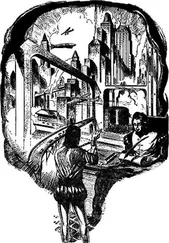The buckle was still open; I could read the numbers on it easily. Almost automatically my hand moved to the buttons. Yes, that was right — the buttons were a keyboard against my waist, the panel was the readout; the whole thing was a little computer.
But what in hell was I computing?
Idly I touched some of the buttons. The panel blinked. One of the dates changed. I pressed another button and the center row of lights flickered. When I pressed the first button again, a different part of the date changed. I didn’t understand it, and there was nothing in the box except some tissue paper.
Maybe there was something on the belt itself I took it off.
On the back of the clasp, it said:
TIMEBELT
TEMPORAL TRANSPORT DEVICE
Temporal Transport Device—? Hah! They had to be kidding.
A time machine? In a belt? Ridiculous. And then I found the instructions.
* * *
The instructions were on the back of the clasp — when I touched it lightly, the words TIMEBELT, TEMPORAL TRANSPORT DEVICE winked out and the first “page” of directions appeared in their place. Every time I tapped it after that, a new page appeared. They were written in a land of linguistic shorthand, but they were complete. The table of contents itself ran on for several pages:
OPERATION OF THE TIMEBELT
Understanding
Theory and Relations
Time Tracking
The Paradox Paradox
Alternity
Discoursing
Protections
Corrections
Tangling and Excising
Excising with Records
Reluctances
Avoidances and Responsibilities
FUNCTIONS
Layout and Controls
Settings
Compound Settings
High-Order
Programming
Safety Features
USAGES
Forward in Time —
By a Specific Amount
To a Particular Moment
Cautions
Backward in Time —
By a Specific Amount
To a Particular Moment
Additional Cautions
Fail-Safe Functions
Compound Jumps —
Advanced
High-Order
Compound Cautions
Distance Jumps —
Medium Range
Long Range
Ultra-Long Range
Special Cautions
Infinity Dangers
Entropy Awareness
Timeskimming —
Short Range
Long Range
Ultra-Long Range
Timestop —
Uses of the Timestop
Stopping the Present
Stopping the Past
Stopping the Future
Special Cautions on the Use of the Timestop
Multiple Jumps—
Programming
Usage
Cautions and Protections on Multiple Jumps
Emergency Jumps—
Returns
Timestops
Timeskims
Height and Motion Compensations (moving vehicles and temporary heights)
Other Compensations (ordinary and specific use)
General Cautions Summary
ACCLIMATIZATIONS
Cultures
Determinations
Languages
Clothing
Shelter
Currency
Living Patterns and Customs
Religions and Taboos
Health
Protocols
Timestop Determinations
Additional Acclimatizations
Cautions
ARTIFACTING
Transporting
Special Cases
Cautions
I was beginning to feel a little dazed — of course this couldn’t be for real. It couldn’t be…
I sat down on the couch and began reading the directions in detail. They were easy to understand. There was a great deal about the principles of operation and the variety of uses, but I just skimmed that.
The readout panel was easy enough to understand. The top row of numbers was the time now; the second row was the distance you wished to travel away from it, either forward or back; and the third row was the moment to which you were traveling, your target. The fourth row was the moment of your last jump — that is, when the belt had last come from. (Later I found that it could also be the date of the next jump if you had preprogrammed for it. Or it could be a date held in storage — one that you could keep permanently set up and jump to at a moment’s decision.)
The letters F and B on the right side, of course, stood for Forward and Back. The letters J and T on the left side stood for Jump and Target. The lights in the center of the panel had several functions; mostly they indicated the belt’s programming.
In each corner of the readout was a lettered square. These were references to four buttons on the face of the buckle itself. (I closed he buckle and looked — there weren’t any obvious buttons, but in each corner was an area that seemed to depress with a slight click.) CLR stood for Clear, HOL meant Hold, RET was Return, and ACT was Activate. Each button had to be pressed twice in rapid succession to function; that way you wouldn’t accidentally change any of your settings or send yourself off on an unintended jaunt,
CLR was meant to clear the belt of all previous instructions and settings. HOL would hold any date in storage indefinitely, or call it out again. RET would send you back to the moment of your last jump, or to any date locked in by HOL. ACT would do just that — act. Whatever instructions had been programmed into the belt, nothing would happen until ACT was pressed. Twice.
There were more instructions. There was something called Timestop and something else called Timeskim. According to the instructions, each was an interrupted time jump resulting in a controlled out-of-phase relationship with the real-time universe. Because the rate of phase congruency could be controlled, so could the perceived rate of the timestream.
What that meant was that I could view events like a motion picture film. I could speed it up and see things happening at an ultra-fast rate via the Timeskim, or I could slow them down — I could even freeze them altogether with the Timestop.
The Timeskim was necessary to allow you to maintain your bearings over a long-range jump; you could skim through time instead of jumping directly. The movement of people and animals would be a blur, but you would be able to avoid materializing inside of a building that hadn’t been there before. The Timestop was intended to help you get your bearings after you arrived, but before you reinserted yourself into the timestream, especially if you were looking for a particular moment. With everything seemingly frozen solid, you could find an unobserved place to appear, or you could remain an unseen observer of the Timestopped still life. Or you could Timeskim at the real-time rate without being a part of real-world events, again an unseen observer. I guessed that the Timestop and Timeskim were necessary for traveling to unfamiliar eras — especially dangerous ones.
There were other functions too, complex things that I didn’t understand yet. I decided to leave them alone for a while. For instance, Entropy Awareness left me a bit leery. I concentrated on the keyboard instead. If I was going to use this thing, I’d better know how to program it.
The top two buttons controlled Jump and Target, Forward and Back. The second row of six controlled any six digits of the date; the third row of three was for programming — they determined the settings of the second and fourth rows. The fourth row had six buttons; used in combination with the third row, they determined ways of using the belt. Maybe more. Each of the buttons on the keyboard was multi-functional. What it controlled, and how, was determined by which other buttons it was used in combination with.
Clearly this timebelt was not a simple device. There was a lot to learn.
* * *
I felt like a kid with a ten-dollar bill in a candy store — no, like an adolescent with a hundred-dollar bill in a brothel.
Читать дальше











